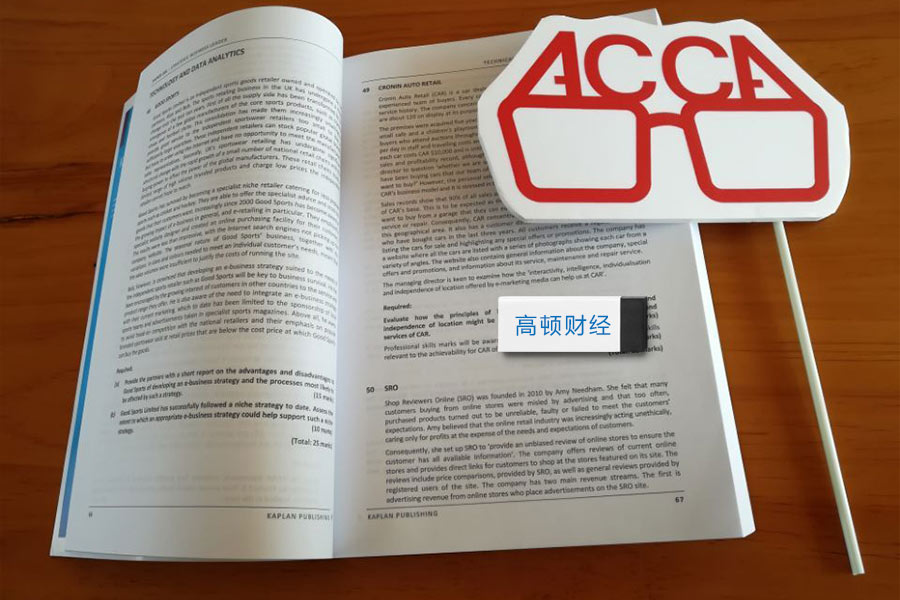ACCA F7考官文章《LEASE - OPERATING OR FINANCE 》
来源:
高顿网校
2014-12-15
This article is relevant to Papers F7 and P2
Complex lease terms mean that it is often difficult to determine how they should be classified. This article examines IAS 17 and sheds some light on the matter
Leases are classified currently under IAS 17, Leases, as finance or operating leases at inception, depending on whether substantially all the risks and rewards of ownership transfer to the lessee. Under a finance lease, the lessee has substantially all of the risks and reward of ownership. Situations that would normally lead to a lease being classified as a finance lease include the following:
the lease transfers ownership of the asset to the lessee by the end of the lease term
the lease term is for the major part of the economic life of the asset, even if title is not transferred
at the inception of the lease, the present value of the minimum lease payments amounts to at least substantially all of the fair value of the leased asset
the leased assets are of a specialised nature such that only the lessee can use them without major modifications being made
if the lessee is entitled to cancel the lease, the lessor's losses associated with the cancellation are borne by the lessee
gains or losses from fluctuations in the fair value of the residual fall to the lessee
the lessee has the ability to continue to lease for a secondary period at a rent that is substantially lower than market rent
All other leases are operating leases.
The lease classification is made at the inception of the lease but a lessee and lessor may agree to change the provisions of the lease. However, changes in estimates for example, changes in the residual value of a leased property, or changes in circumstances such as default by the lessee, do not give rise to a new classification of a lease. If the changes would have resulted in a different lease classification, had they been applied originally, then the revised lease agreement is treated as a new lease over the remaining lease term. The original accounting entries are not retrospectively amended.
Often lease indicators may not always point in the same direction causing lease classification to be difficult. Leases of specialised assets will usually be structured as finance leases. If an asset is specialised, then this implies that no other entity has a use for the asset. Consequently the lessor will only achieve its return on investment through the lease payments and it will structure the lease as a finance lease accordingly. If a lessor can sell or lease non-specialised assets to other parties at the end of the lease and is willing to accept the financial risk on this then this could be an indicator of an operating lease. Assets of a non-specialised may become specialised. For example, leased plant and equipment may be permanently installed in a building and its removal at the end of the lease may be impractical or too expensive for the lessor. Often specialised assets may have a significant remaining life at the end of the lease and sometimes this remaining life may be the major part of the economic life of the asset and therefore this indicator will point to it being an operating lease. However, it may be appropriate to disregard this indicator. Normally for there to be an operating lease with a significant part of the assets life remaining, there needs to be some realisation of funds through sale or further rentals. However, in the case of a specialised asset this will not normally occur, because it is of value only to the lessee. In these cases, the asset will normally transfer to the lessee at the end of the lease for a nil or nominal payment and be treated as a finance lease.
Where an asset has been leased several times during its economic life, and the lease is the last lease to take the asset to the end of its life, then many of the indicators may point towards a finance lease. For example, the present value of the minimum lease payments may approximate to the fair value of the asset at the inception of the final lease and there is unlikely to be an option to purchase the asset at fair value or to extend the lease at a market rent because the asset has reached the end of its life. However the asset will obviously be non-specialised and the final lease will not be for the major part of the economic life of the asset. The lease will be for the entire remaining useful life of the asset but IAS 17, Leases, focuses on economic life as an indicator of a finance lease. The lessor is recovering the investment in the asset through a number of leases and the substance of each of those leases will normally be an operating lease. Thus if the final lease were to be classified as a finance lease simply because of its position in the chain, this would normally be unacceptable.
Where an asset is leased and rents are nominal rents, the agreement is still a lease under IAS 17. The total value of the rents will fall short of the fair value of the asset, thus indicating an operating lease. Often, the rents are low because a premium will have been paid up-front which may be equivalent to substantially all of the fair value of the asset. In this case, the lease is probably a finance lease. Where rents are very low and no premium has been paid, the lease does not have a commercial basis and it would appear that the lessor is indifferent to the risks and rewards of ownership. Lease classification, in this case, is better judged by looking at the substance of the arrangement and the intentions of the lessor in granting a lease on such terms.
The presence of an option to extend the lease at substantially less than a market rent implies that the lessor expects to achieve its return on investment solely through the lease payments and therefore is content to continue the lease for a secondary period at a nominal rental. This is an indicator of a finance lease. It is reasonable to assume that the lessee will extend the lease in these circumstances. However, an option to extend it at a market rental may indicate that the lessor has not achieved its return on investment through the lease rentals and therefore is relying on a subsequent lease or sale to do so. This is an indicator of an operating lease as there will be no compelling commercial reason why the lessee should extend the agreement. The absence of any option to extend the lease does not provide evidence either way as to an operating or a finance lease and other factors will need to be considered to determine the classification.
In some cases, fluctuations in the fair value of the residual interest in the leased asset are passed back to the lessee. This indicates that the lessee is bearing the residual value risk, and the lessor’s return on investment is effectively fixed.
These indicators provide evidence of a finance lease. If the lease also requires the lessee to make good to the lessor any shortfall between the sale proceeds and a fixed ‘residual’ amount, then again this is evidence of the lessor’s return being fixed. Where the lessor retains the proceeds of the eventual sale of the asset, the lessor is bearing the residual value risk and where the sale proceeds are significant, then this could be evidence of an operating lease.
Issues sometimes arise in lease contracts where an asset is held on a finance lease and then it is all or partially sub- let to another party on identical terms and conditions. This can occur where several entities intend to share leased accommodation and arrange for one entity to lease the whole asset and then sub-let the relevant parts to the others. The issue that arises here is whether the lead entity should recognise the finance leases on a gross basis in its accounts or whether it should net off the transactions in its accounts.
In this case the entity should currently look at the de-recognition requirements of IAS 39, Financial Instruments: Recognition and Measurement. The treatment will depend on the terms of the individual transaction. If the two transactions are separate to the extent that the lead entity is liable to pay its rentals under the head-lease regardless of whether it actually receives its sub-lease rentals, then the de-recognition requirements will not be met and it will need to account for the two leases on a gross basis.
A contingent rent is such amount that is paid as part of lease payments but is not fixed or agreed in advance at the inception of lease rather the amount to be paid is dependent on some future event. However, it is not an interest payment as it is not connected with the passage of time therefore time value of money is not an issue. Contingent rent is commonly connected with an increase or decrease in future sales by the lessee or increase or decrease in the use of asset or inflation or deflation. Under IAS 17, contingent rents are excluded from minimum lease payments and are accounted as expense/income in the period in which they are incurred/earned.
If a lease contains a clean break clause, where the lessee is free to walk away from the lease agreement after a certain time without penalty, then the lease term for accounting purposes will normally be the period between the commencement of the lease and the earliest point at which the break option is exercisable by the lessee. If a lease contains an early termination clause that requires the lessee to make a termination payment to compensate the lessor such that the recovery of the lessor’s remaining investment in the lease was assured, then the termination clause would normally be disregarded in determining the lease term. Similarly the same principle applies, if the lease agreement states that the lease can only be terminated in remote circumstances, with the permission of the lessor or on entering a new lease agreement for the same or equivalent asset.
The IASB is preparing a standard that may clarify and change some of the above aspects of lease accounting. The current models lead to a lack of comparability and undue complexity because of the distinction between finance and operating leases. As a result, many users of financial statements adjust the amounts presented in the statement of financial position to reflect the assets and liabilities arising from operating leases which makes the deliberations of companies regarding classification of leases somewhat a futile exercise.
Written by a member of the Paper P2 examining team
版权声明:本条内容自发布之日起,有效期为一个月。凡本网站注明“来源高顿教育”或“来源高顿网校”或“来源高顿”的所有作品,均为本网站合法拥有版权的作品,未经本网站授权,任何媒体、网站、个人不得转载、链接、转帖或以其他方式使用。
经本网站合法授权的,应在授权范围内使用,且使用时必须注明“来源高顿教育”或“来源高顿网校”或“来源高顿”,并不得对作品中出现的“高顿”字样进行删减、替换等。违反上述声明者,本网站将依法追究其法律责任。
本网站的部分资料转载自互联网,均尽力标明作者和出处。本网站转载的目的在于传递更多信息,并不意味着赞同其观点或证实其描述,本网站不对其真实性负责。
如您认为本网站刊载作品涉及版权等问题,请与本网站联系(邮箱fawu@gaodun.com,电话:021-31587497),本网站核实确认后会尽快予以处理。
点一下领资料
【整理版】ACCA各科目历年真题
真题高频考点,刷题全靠这份资料
下载合集
acca全科学习思维导图
梳理核心考点,一图看懂全部章节
下载合集
2023年acca考纲解析
覆盖科目重难点,备考按照计划走
下载合集
acca备考 热门问题解答
- acca考试怎么搭配科目?
-
建议优先选择相关联的科目进行搭配报考,这样可以提高备考效率,减轻备考压力,1、F1-F4:为随时机考科目,难度较低,这里可以自行随意选择考试顺序。2、F5-F9:如果你的工作的和财务会计或者审计有关、或者你比较擅长财务和审计的话,推荐先考F7和F8。你可以选择一起考ACCA考试科目F7和F8或者先考F7(8)再考F8(7),这就要取决你一次想考几门。3、P阶段:选修科目中,建议企业首选AFM!第二部分科目进行选择,如果AA和SBR掌握学生更好,可以通过选择AAA,如果SBL掌握的好,可以自己选择APM。
- acca一共几门几年考完?
-
acca一共有15门考试科目,其中有必修科目和选修科目,考生需要考完13门科目才能拿下证书。
- acca一年考几次?
-
acca一年有4次考试,分别是3月、6月、9月和12月,分季机考科目是采取的这类四个考季的模式,而随时机考则是没有这方面的时间规定限制,可以随报随考。
- acca的含金量如何?
-
ACCA证书的含金量是比较高的,从就业、能力提升、全球认可等角度来说,都是比较有优势的证书,其含金量主要表现在以下几个方面:1、国际化,认可度高;2、岗位多,就业前景好;3、缺口大,人才激励。
严选名师 全流程服务
其他人还搜了
热门推荐
-
长春ACCA培训课程,高顿ACCA推荐吗? 2023-06-19
-
【考试重点】acca2023年9月SBL变化详解,速进了解! 2023-06-19
-
acca《PM业绩管理》考试大纲变化,2023年9月起变动情况一览! 2023-04-26
-
2023年6月acca考试哪些科目考纲有变化?赶快来看! 2023-04-25
-
ACCA2023年考试重点介绍,新手看过来! 2023-03-29
-
9月acca考试考纲变了吗?这些科目变动你要了解! 2023-03-10
-
acca考纲每次变化大吗?2023年9月起变动0%-12%! 2023-03-10
-
ACCA科目名称英文一览 2022-05-23
-
ACCA都考什么内容? 2022-05-20
-
ACCA课程内容介绍 2022-05-12
-
2022年ACCA考试一共要考几科? 2022-05-11
-
ACCA的考试内容都有什么? 2022-05-10
-
ACCA官网操作 | 如何鉴别自己是FIA还是ACCA&考试报名退考流程 2021-06-30
-
2020年最新ACCA考试大纲哪里找? 2020-03-04
-
2014年12月ACCA考试改动方向及难度变化,资阳考生必看! 2019-01-04
-
2014年12月ACCA考试改动方向及难度变化,资阳考生必看! 2019-01-04
-
2018年ACCA考试新旧考纲变化详解 2019-01-02
-
12月ACCA考试前瞻:2017年9月ACCA F7考试分析 2017-11-21
-
ACCA考试F8考试大纲变化解析 2017-04-19
-
ACCA考试F7考纲变化分析 2017-01-04
-
acca福建厦门考点i831在哪里 2016-12-19
-
拉萨有没有比较好的ACCA培训机构? 2016-06-29
-
石嘴山有没有比较好的ACCA培训机构? 2016-06-29
-
嘉峪关有没有比较好的ACCA培训机构? 2016-06-29
-
吐鲁番有没有比较好的ACCA培训机构? 2016-06-29
-
武夷山有没有比较好的ACCA培训机构? 2016-06-29
-
保山有没有比较好的ACCA培训机构? 2016-06-22
-
果洛有没有比较好的ACCA培训机构? 2016-06-22
-
临夏有没有比较好的ACCA培训机构? 2016-06-22
-
喀什有没有比较好的ACCA培训机构? 2016-06-22
 更多服务
更多服务




























